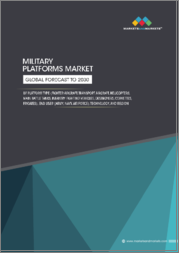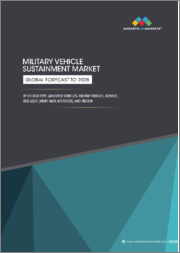
|
시장보고서
상품코드
1568476
세계의 군용 차량 유지보수 시장 : 기회, 성장 촉진요인, 산업 동향 분석 및 예측(2024-2032년)Military Vehicle Sustainment Market, Opportunity, Growth Drivers, Industry Trend Analysis and Forecast, 2024-2032 |
||||||
세계 군용 차량 유지보수 시장은 국방비 증가와 군용 차량 현대화에 대한 지속적인 노력으로 2024-2032년간 연평균 5%의 성장률을 나타낼 것으로 예상됩니다.
세계 각국 정부는 새로운 안보 도전에 대응하기 위해 군사력을 강화하고 있으며, 기존 군용 차량의 유지 및 업그레이드에 큰 비중을 두고 있습니다. 이러한 추세는 지정학적 긴장이 고조되고 첨단 방어 기술의 필요성이 증가함에 따라 더욱 증폭되고 있습니다. 효율적이고 신뢰할 수 있는 유지보수 솔루션에 대한 수요가 급증하고 있으며, 육, 공, 해상의 모든 영역에서 작전 대응력을 보장하고 군용 차량의 수명 주기를 연장할 수 있을 것으로 기대됩니다.
변속기 시스템 및 부품 분야는 2024년부터 2032년까지 큰 폭으로 성장할 것으로 예상됩니다. 군용 차량이 더욱 정교해지고 기동성과 내구성이 요구됨에 따라 첨단 변속기 시스템에 대한 필요성이 증가하고 있습니다. 이러한 시스템은 복잡한 군사 작전에 필수적인 동력 배분, 속도, 기동성 등 차량 성능을 향상시키는 데 중요한 역할을 합니다. 변속기 제조업체들은 혹독한 전투 환경을 견딜 수 있는 견고하고 효율적인 변속기 시스템 개발에 주력하고 있습니다.
공군 최종 사용자 부문은 2032년까지 군용 차량 유지보수 시장에서 큰 비중을 차지할 것으로 예상됩니다. 현대전에서 공중권력의 중요성이 증가함에 따라 전 세계 공군은 보유 항공기의 정비와 강화를 우선순위로 삼고 있습니다. 항공기 및 관련 지상 지원 차량의 유지 관리 활동은 작전 준비태세 유지에 필수적입니다. 엔진 점검, 항공전자 업그레이드, 구조 변경 등 전문 서비스에 대한 수요가 증가하고 있습니다.
유럽의 군용 차량 유지보수 시장은 2024년부터 2032년까지 강력한 성장세를 보일 것으로 예상됩니다. 이러한 성장은 이 지역의 강력한 방위 산업 기반, 국방 현대화에 대한 막대한 투자, 진화하는 안보 과제에 대한 대응력 유지에 중점을 두고 있는 데 기인합니다. 유럽 국가들은 국방력을 강화하기 위해 노력하고 있으며, 특히 기존 군용 차량 함대의 업그레이드와 유지에 중점을 두고 있습니다. 대형 방산업체들의 존재와 각국 정부의 방산 이니셔티브에 대한 광범위한 지원은 이 지역 시장을 더욱 강화시키고 있습니다.
목차
제1장 조사 범위와 조사 방법
- 시장 범위와 정의
- 기본 추정과 계산
- 예측 파라미터
- 데이터 소스
- 1차 데이터
- 2차 데이터
- 유료 소스
- 공적 정보원
제2장 주요 요약
제3장 업계 인사이트
- 생태계 분석
- 벤더 매트릭스
- 기술 및 혁신 전망
- 특허 분석
- 주요 뉴스와 이니셔티브
- 규제 상황
- 영향요인
- 성장 촉진요인
- 업계의 잠재적 리스크&과제
- 성장 가능성 분석
- Porter's Five Forces 분석
- PESTEL 분석
제4장 경쟁 구도
- 기업 점유율 분석
- 경쟁 포지셔닝 매트릭스
- 전략 전망 매트릭스
제5장 시장 추산·예측 : 서비스 유형별, 2021년-2032년
- 주요 동향
- 유지보수
- 수리
- 점검
- 공급망 관리
- 트레이닝 및 지원
제6장 시장 추산·예측 : 컴포넌트별, 2021년-2032년
- 주요 동향
- 엔진 시스템
- 변속기 시스템
- 전기 시스템
- 무기 시스템
- 장갑 및 보호 시스템
- 기타
제7장 시장 추산·예측 : 최종사용자별, 2021년-2032년
- 주요 동향
- 육군
- 공군
- 해군
- 기타 방위 조직
제8장 시장 추산·예측 : 2021년-2032년 : 유지 단계별
- 주요 동향
- 현장 레벨 정비
- 창고 레벨 정비
제9장 시장 추산·예측 : 차량 유형별, 2021년-2032년
- 주요 동향
- 전투 차량
- 전차
- Armored personnel carriers (APCs)
- Infantry fighting vehicles (IFVs)
- 자주포
- 전술 차량
- 경전술차
- 중형 전술차
- 중전술차
- 지원 차량
- 물류 차량
- 메인터넌스 차량
- 의료 반송차
- 지휘 통제차
- 무인지상차량(UGV)
- 정찰용 UGV
- 전투용 UGV
- 물류 UGV
- EOD(폭발물 처리)용 UGV
제10장 시장 추산·예측 : 지역별, 2021년-2032년
- 주요 동향
- 북미
- 미국
- 캐나다
- 유럽
- 영국
- 독일
- 프랑스
- 이탈리아
- 스페인
- 기타 유럽
- 아시아태평양
- 중국
- 인도
- 일본
- 한국
- 뉴질랜드
- 기타 아시아태평양
- 라틴아메리카
- 브라질
- 멕시코
- 기타 라틴아메리카
- 중동 및 아프리카
- 아랍에미리트(UAE)
- 사우디아라비아
- 남아프리카공화국
- 기타 중동 및 아프리카
제11장 기업 개요
- AM General LLC
- BAE Systems plc
- Elbit Systems Ltd.
- FNSS Defence Systems
- General Dynamics Corporation
- Hanwha Defense
- Iveco Defence Vehicles
- Kongsberg Gruppen ASA
- Krauss-Maffei Wegmann GmbH and Co. KG
- Leonardo S.p.A.
- Lockheed Martin Corporation
- Navistar Defense, LLC
- Northrop Grumman Corporation
- Oshkosh Defense, LLC
- Raytheon Technologies Corporation
- Rheinmetall AG
- Saab AB
- Textron Systems
- Thales Group
The Global Military Vehicle Sustainment Market is set to grow at 5% CAGR from 2024 to 2032, driven by increasing defense expenditures and ongoing efforts to modernize military fleets. Governments worldwide are enhancing their military capabilities to address emerging security challenges, with a significant focus on maintaining and upgrading existing military vehicles. This trend is further amplified by the growing geopolitical tensions and the need for advanced defense technologies. The demand for efficient and reliable sustainment solutions is expected to surge, ensuring operational readiness and extending the life cycle of military vehicles across land, air, and sea domains.
The overall Military Vehicle Sustainment Industry is categorized based on Service Type, End-User, Component, Sustainment Phase, Vehicle Type, Frequency Band, and Region.
The transmission systems component segment will witness substantial growth between 2024 and 2032. As military vehicles become more sophisticated and require greater mobility and durability, the need for advanced transmission systems is rising. These systems play a crucial role in enhancing vehicle performance, including power distribution, speed, and maneuverability, essential for complex military operations. Manufacturers are focusing on developing robust and efficient transmission systems that can withstand harsh combat environments.
The Air Force end-user segment is poised to capture a significant share of the military vehicle sustainment market by 2032. With the increasing importance of air superiority in modern warfare, air forces globally are prioritizing the maintenance and enhancement of their fleets. Sustainment activities for aircraft and related ground support vehicles are critical to maintaining operational readiness. The demand for specialized services, including engine overhauls, avionics upgrades, and structural modifications, is on the rise.
Europe military vehicle sustainment market will experience robust growth throughout 2024-2032. This growth is attributed to the region's strong defense industrial base, significant investments in defense modernization, and a high focus on maintaining readiness amidst evolving security challenges. European countries are committed to strengthening their defense capabilities, with a particular emphasis on upgrading and sustaining existing military vehicle fleets. The presence of leading defense contractors and extensive government support for defense initiatives further bolster the market in this region.
Table of Contents
Chapter 1 Scope and Methodology
- 1.1 Market scope and definition
- 1.2 Base estimates and calculations
- 1.3 Forecast parameters
- 1.4 Data sources
- 1.4.1 Primary
- 1.4.2 Secondary
- 1.4.2.1 Paid sources
- 1.4.2.2 Public sources
Chapter 2 Executive Summary
- 2.1 Industry 360° synopsis, 2024 - 2032
- 2.2 Business trends
- 2.2.1 Total addressable market (TAM), 2024-2032
Chapter 3 Industry Insights
- 3.1 Industry ecosystem analysis
- 3.2 Vendor matrix
- 3.3 Technology and innovation landscape
- 3.4 Patent analysis
- 3.5 Key news and initiatives
- 3.6 Regulatory landscape
- 3.7 Impact forces
- 3.7.1 Growth drivers
- 3.7.1.1 Increasing military expenditures
- 3.7.1.2 Aging fleet and equipment modernization
- 3.7.1.3 Technological advancements
- 3.7.1.4 Focus on modular and upgradeable designs
- 3.7.1.5 Adoption of predictive maintenance
- 3.7.2 Industry pitfalls and challenges
- 3.7.2.1 Supply chain disruptions
- 3.7.2.2 Technological integration
- 3.7.1 Growth drivers
- 3.8 Growth potential analysis
- 3.9 Porter's analysis
- 3.9.1 Supplier power
- 3.9.2 Buyer power
- 3.9.3 Threat of new entrants
- 3.9.4 Threat of substitutes
- 3.9.5 Industry rivalry
- 3.10 PESTEL analysis
Chapter 4 Competitive Landscape, 2023
- 4.1 Company market share analysis
- 4.2 Competitive positioning matrix
- 4.3 Strategic outlook matrix
Chapter 5 Market Estimates and Forecast, By Service Type, 2021 - 2032 (USD Billion)
- 5.1 Key trends
- 5.2 Maintenance
- 5.3 Repair
- 5.4 Overhaul
- 5.5 Supply chain management
- 5.6 Training and support
Chapter 6 Market Estimates and Forecast, By Component, 2021 - 2032 (USD Billion)
- 6.1 Key trends
- 6.2 Engine systems
- 6.3 Transmission systems
- 6.4 Electrical systems
- 6.5 Weapons systems
- 6.6 Armor and protection systems
- 6.7 Others
Chapter 7 Market Estimates and Forecast, By End-User, 2021 - 2032 (USD Billion)
- 7.1 Key trends
- 7.2 Army
- 7.3 Air force
- 7.4 Navy
- 7.5 Other defense organizations
Chapter 8 Market Estimates and Forecast, By Sustainment Phase, 2021 - 2032 (USD Billion)
- 8.1 Key trends
- 8.2 Field-level maintenance
- 8.3 Depot-level maintenance
Chapter 9 Market Estimates and Forecast, By Vehicle Type, 2021 - 2032 (USD Billion)
- 9.1 Key trends
- 9.2 Combat Vehicles
- 9.2.1 Tanks
- 9.2.2 Armored personnel carriers (APCs)
- 9.2.3 Infantry fighting vehicles (IFVs)
- 9.2.4 Self-propelled artillery
- 9.3 Tactical Vehicles
- 9.3.1 Light tactical vehicles
- 9.3.2 Medium tactical vehicles
- 9.3.3 Heavy tactical vehicles
- 9.4 Support Vehicles
- 9.4.1 Logistics vehicles
- 9.4.2 Maintenance vehicles
- 9.4.3 Medical evacuation vehicles
- 9.4.4 Command and control vehicles
- 9.5 Unmanned Ground Vehicles (UGVs)
- 9.5.1 Reconnaissance UGVs
- 9.5.2 Combat UGVs
- 9.5.3 Logistics UGVs
- 9.5.4 EOD (Explosive Ordnance Disposal) UGVs
Chapter 10 Market Estimates and Forecast, By Region, 2021 - 2032 (USD Billion)
- 10.1 Key trends
- 10.2 North America
- 10.2.1 U.S.
- 10.2.2 Canada
- 10.3 Europe
- 10.3.1 UK
- 10.3.2 Germany
- 10.3.3 France
- 10.3.4 Italy
- 10.3.5 Spain
- 10.3.6 Rest of Europe
- 10.4 Asia Pacific
- 10.4.1 China
- 10.4.2 India
- 10.4.3 Japan
- 10.4.4 South Korea
- 10.4.5 ANZ
- 10.4.6 Rest of Asia Pacific
- 10.5 Latin America
- 10.5.1 Brazil
- 10.5.2 Mexico
- 10.5.3 Rest of Latin America
- 10.6 MEA
- 10.6.1 UAE
- 10.6.2 Saudi Arabia
- 10.6.3 South Africa
- 10.6.4 Rest of MEA
Chapter 11 Company Profiles
- 11.1 AM General LLC
- 11.2 BAE Systems plc
- 11.3 Elbit Systems Ltd.
- 11.4 FNSS Defence Systems
- 11.5 General Dynamics Corporation
- 11.6 Hanwha Defense
- 11.7 Iveco Defence Vehicles
- 11.8 Kongsberg Gruppen ASA
- 11.9 Krauss-Maffei Wegmann GmbH and Co. KG
- 11.10 Leonardo S.p.A.
- 11.11 Lockheed Martin Corporation
- 11.12 Navistar Defense, LLC
- 11.13 Northrop Grumman Corporation
- 11.14 Oshkosh Defense, LLC
- 11.15 Raytheon Technologies Corporation
- 11.16 Rheinmetall AG
- 11.17 Saab AB
- 11.18 Textron Systems
- 11.19 Thales Group


















